
Sender Zehlendorf or Zehlendorf (radio) transmission facility was a radio transmission facility which was in service since 1936, when a short wave transmitter was built on the occasion of the Berlin 1936 Summer Olympics in Zehlendorf as part of the establishment of permanent radio services. This Zehlendorf site, which until the end of World War II was referred to as the Rehmate Radio Transmission Centre, had 26 different antennas at the time.

The Longwave transmitter Europe 1 was the oldest privately owned radio station in Germany, situated between Felsberg and Berus/Saar, Germany. It transmitted on 183 kHz with a power of 2,000 kilowatts a French speaking programme, Europe 1 toward France. It was the highest power radio broadcasting transmitter in Germany. Longwave transmissions stopped on 31 December 2019.

The Roumoules transmitter is the main broadcasting facility for longwave and mediumwave broadcasting of Radio Monte Carlo near Roumoules, France and is owned by Monaco Media Diffusion. The 1000 and 2000kW transmitters installed are among the most powerful in the world and can be received well at nighttime throughout Europe.
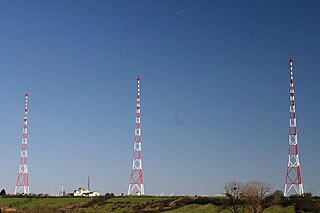
The Junglinster Longwave Transmitter is a longwave broadcasting facility used by RTL near Junglinster, Luxembourg, which went into service in 1932. Its aerial consists of three free-standing steel-framework towers, which are ground fed radiators. These towers formed a directional aerial for the frequency 234 kHz and until 1980 were 250 metres high. Since 1980 their height has been 215 metres.

The Mühlacker Broadcasting Transmission Facility is a radio transmission facility near Mühlacker, Germany, first put into service on November 21, 1930. It uses two guyed steel tube masts as aerials and one guyed steel framework mast, which are insulated against ground. It has two transmission aerials for shortwave and one free standing steel framework tower for directional radio services. The shortwave transmitter was shut off on October 19, 2004. The medium wave transmitter was switched off in January 2012.

The AM transmitter in Burg, near Magdeburg, Germany, is a huge facility for longwave and mediumwave broadcasting. Its most dominant constructions are a 324-metre guyed radio mast and two 210 metre guyed steel tube masts.
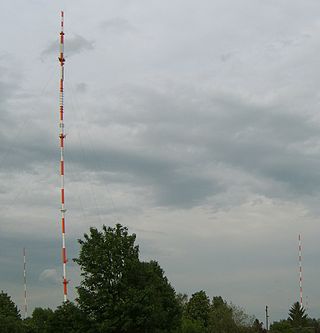
The Transmitter Hamburg-Billstedt is a broadcasting facility in Hamburg-Billstedt, established in 1934. It is owned and operated by the Norddeutscher Rundfunk public broadcasting service, but open to competitors, too.

Transmitter Berlin-Britz was a broadcasting facility for medium wave, shortwave and FM on the site of a former tree nursery in Berlin-Britz. It was established in 1946 and until 1993 it was the most important transmitter of RIAS. It was used by Deutschlandradio until 4 September 2013, and was finally demolished on 18 July 2015.

The Skelton Transmitting Station is a radio transmitter site at grid reference NY433376 near Skelton, Cumbria, England, about 5 miles (8 km) north-west of Penrith, run by Babcock International and owned by the Ministry of Defence. Since the Belmont Mast in Lincolnshire was shortened in 2010, the mast at Skelton has been the tallest structure in the United Kingdom.

The Rheinsender is an FM radio transmission site for the German Südwestrundfunk regional public broadcasting system. The Rheinsender is located near Wolfsheim, southwest of Mainz.
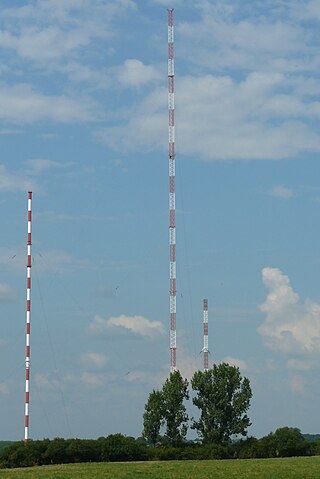
The Cremlingen transmitter is a large mediumwave transmission facility established in 1962 for transmitting the programme of Deutschlandfunk on 756 kHz near Cremlingen-Abbenrode. It was also known as Sender Braunschweig or Sender Königslutter.

The Heusweiler transmitter was a facility for medium wave broadcasting north of Heusweiler, Germany. It originally went into service on 23 December 1935. On 19 June 1946 transmitter Heusweiler went in service again.
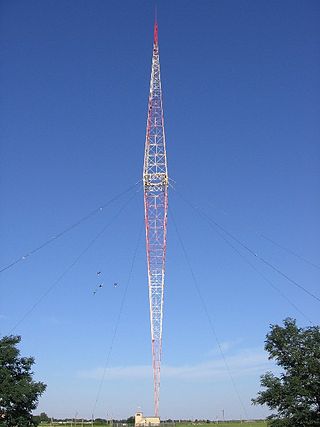
The Lakihegy Tower is a 314-metre-high (1,031 ft) radio mast at Szigetszentmiklós-Lakihegy in Hungary. The Blaw-Knox type tower was built in 1933 and was one of Europe's tallest structures at the time of construction. It was designed to provide broadcast coverage for Hungary with a 120 kW transmitter. It was built for the purpose of transmitting the radio station "Budapest I.", which it served until 1977.

The Mediumwave transmitter Lopik was a medium wave broadcasting facility near Lopik in the Netherlands. It was constructed in 1938 and destroyed on September 1, 2015. Its last use was to transmit the Dutch language edition of Radio Maria on 675 kHz. The aerial consisted of a 196-metre (643 ft) guyed steel framework mast, which was insulated against ground.
The mediumwave transmitter Flevoland was a broadcasting facility for medium wave near Zeewolde in the province of Flevoland, Netherlands, situated at 5°25′ E and 52°23′ N. It has been used for broadcasting on 747 kHz and 1008 kHz with a nominal power of 400 kilowatts. As aerial two guyed steel framework masts with a height of 195 metres are used, which form an anti-fading aerial. These masts are grounded and carry a cage aerial, which is upperward the separation insulator, separating the masts in a height of 95 metres in two parts, connected toward the mast construction. The radiation diagram is directional, with a maximum gain of 4 dB in South-Eastern direction, to compensate for the variation in electrical admittance of terrain in the Netherlands.
Transmitter Koszęcin is a facility for mediumwave and FM broadcasting near Koszecin, Poland. It was opened in 1977. It has two guyed masts: the first one is 110 metres high, is grounded, and carries antennas for FM broadcasting ; the second is 138m high. That second mast is insulated from ground and used for mediumwave transmission; broadcasting of the Radio Pahonia in Belarusian is planned on 1080 kHz with ERP 350 kW using this mast. The signal will cover the whole of Europe including the Ural Mountains. Earlier, the AM Mast was used for Polish Radio and used two Tesla transmitters 750 kW each in parallel. With the transmitted power of 1500 kW it was one of the most powerful mediumwave transmitters in the world.

The Hirschlanden transmitter was a facility of the Deutsche Telekom AG for mediumwave broadcasting south of Ditzingen-Hirschlanden situated at 48°49'47" N and 9°02'15" E.

The Wiederau transmitter is the oldest broadcasting facility in Saxony. It is located near Wiederau, a village which is part of the municipality of Pegau, and is used for medium-wave, FM and Television broadcasting.
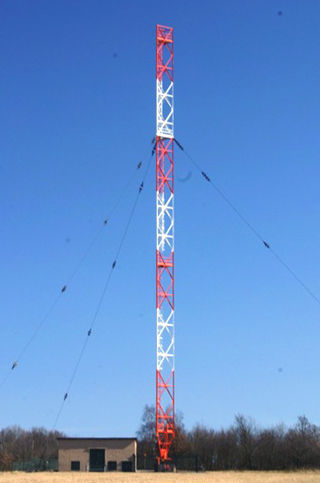
Marnach transmitter was a broadcasting facility of RTL near Marnach in the commune of Clervaux, in northern Luxembourg. The Marnach transmitter was built in 1955 for improving the transmission of the English-speaking program on 1439 kHz, which was transmitted from 1951 with an omnidirectional antenna from Junglinster, to the British Isles and for a better transmission on this frequency to Germany at daytime. Therefore, it was given a directional antenna with a switchable directional characteristic pointing north-northeast towards the Rhine-Ruhr area, Germany's most populated area, and west-northwest in the direction of the UK. This antenna was implemented in form of a directional antenna consisting of three ground-fed 105-metre-tall (350 ft) guyed mast antennas arranged in the form of an isosceles triangle with a 90-degree angle. As transmitters, two 100 kW units switched in parallel were used when it went in service in December 1955.

Weiskirchen transmitter, is a mediumwave broadcasting tower in Weiskirchen, Germany. It is the property of Hessischer Rundfunk. It was built in 1967




















